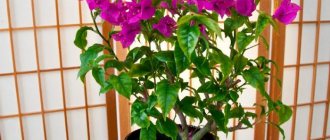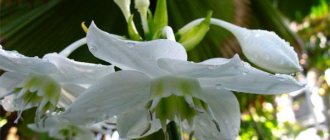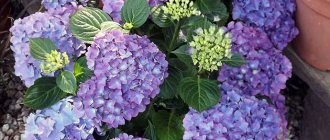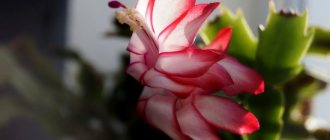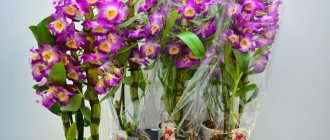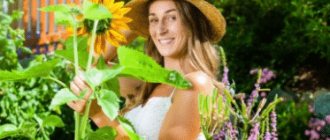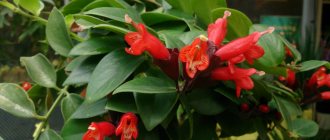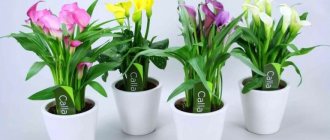The bougainvillea plant has probably been seen by people who are not at all interested in home gardening, but who went (often or even once) on vacation to Turkey, Egypt or the Emirates. There, near popular hotels, you can almost always admire these lushly flowering bushes, literally dotted with flowers of various colors. Sometimes they act as charming hedges, because the stems of bougainvillea are armed with quite strong thorns.
Types of flowers and their descriptions
In their native Latin America, bougainvilleas are represented by 14 species, most of which grow in the mountainous regions of Brazil. And some types of bougainvillea have firmly taken root in human homes, becoming worthy potted crops. Most often they are presented:
- Bougainvillea beautiful, distinguished by elongated flowers framed by lilac-colored bracts, and most often grown indoors as an hanging plant;
- Aster gold , which is characterized by double bracts of orange and red-orange shades;
- Bougainvillea glabra (smooth), characterized by long and abundant flowering, in which its bracts acquire apricot, pink, lemon and salmon colors;
- Astro pink , which also blooms very profusely with pink-coral bracts;
- Bougainvillea peruviana, which has the ability to bloom luxuriantly several times during the season, for which it is pruned;
- California gold, distinguished by large bracts of a radical yellow color, which gradually lighten over time;
- Black India Red, standing out with its rich purple-crimson bracts against a background of dark green leaves.
Did you know? In addition to its decorative qualities, bougainvillea is famous in its homeland for its ability to fight diseases of the upper respiratory tract, as well as hepatitis, hypotension and diabetes.
Varietal diversity
Among the many varieties and varieties of bougainvillea, several are adapted for home cultivation.
Naked
Bushes are dwarf and tall. They produce white flowers surrounded by pink, purple, and red bracts.
Advantages and disadvantages
easy to form; Flowering occurs earlier than other varieties.
there are thorns on the branches; In cool conditions, the period of formation of bracts is reduced.
The culture can be used for vertical gardening.
I like it I don't like it
Beautiful
The bush in nature reaches a height of 15 meters. The bracts are pink or purple.
Advantages and disadvantages
beautiful appearance; forms inflorescences from April to October.
Over time, the bracts turn pale; Due to its tall growth, the crop is not suitable for small areas.
Strong shoots of the vine are able to independently stretch up the support.
I like it I don't like it
Peruvian
The shoots of this bougainvillea are long, but lateral branches are poorly formed on them. The bracts are pink and purple.
Advantages and disadvantages
possibility of use for vertical gardening; Beautiful double bracts are formed.
Beautiful double bracts are formed. the shoots have short thorns.
This variety of bougainvillea can cross with others to form new varieties.
I like it I don't like it
Australian Gold
Beautiful orange-orange bracts form on the shoots of Australian gold. Over time they become salmon-like.
Advantages and disadvantages
spectacular appearance; served to the formation.
the color of the bracts changes; gets sick when there is excess moisture at the base of the root system.
During the year, with good maintenance, the plant can bloom several times.
I like it I don't like it
Double Lilarose
The color of the bracts has shades of pink, salmon, and lilac. With its spectacular appearance, the variety can decorate any area.
Advantages and disadvantages
ease of care; long flowering period.
blooms poorly in low light; If there is a lack of iron in the soil, it can develop chlorosis.
The variety attracts attention with bracts that look like flames. I like it I don't like it
I like it I don't like it
Beggum Sikkander
This bougainvillea delights with white and pink bracts that can form several times a year.
Advantages and disadvantages
elegant appearance of the bush; long flowering.
when the air in the room is too dry, spider mites appear; in low light the shoots stretch out.
A plant with delicate white and pink bracts visually expands the space.
I like it I don't like it
White Cascade
This is a short representative of culture. The buds are white, the bracts are ivory-colored.
Advantages and disadvantages
the variety is suitable for growing in a small room; long flowering.
reacts poorly to temperature changes; needs good lighting.
The plant gives the room an elegant look.
I like it I don't like it
Double Red
The tree consists of dense stems with green leaves and crimson double bracts.
Advantages and disadvantages
beautiful appearance; The bracts have a double shape.
reacts poorly to moving the pot from place to place; requires humidified air.
The decorative variety is very popular among gardeners.
I like it I don't like it
California Gold
For most of the year, the crop is covered with yellow or golden bracts.
Advantages and disadvantages
spectacular appearance of the plant; long flowering.
with a lack of light, flowers form poorly; towards the end of flowering, the bracts lighten.
The low plant is used in office and room settings.
I like it I don't like it
Alexandra
The shrub reaches a height of 3 meters. Bright lilac bracts are formed from May to October.
Advantages and disadvantages
grows quickly; blooms for a long time.
does not tolerate stagnant water; requires good lighting.
The variety is used for growing crops in the form of bonsai.
I like it I don't like it
Mini Thai
Plants of this variety are compact. Double bracts are colored red.
Advantages and disadvantages
ease of care; leaves and bracts are brightly colored.
requires keeping in good light; Feeding is required to form bright bracts.
The variety is suitable for growing in small spaces.
I like it I don't like it
Buttiana
This is a hybrid of naked and Peruvian bougainvillea. Valued for its ability to be used as a bonsai.
Advantages and disadvantages
easily tolerates pruning; has a compact appearance.
requires maintenance at high air humidity; If not cared for properly, it can get sick.
Bougainvillea Buttiana can be used to form a bush in the shape of a wreath or heart.
I like it I don't like it
Reproduction methods at home
You can propagate this plant at home in three ways:
- Seeds that are quite easy to use, but very problematic to purchase, since indoor bougainvillea does not produce seeds, and purchasing seeds in a retail chain is quite expensive. After soaking for four hours in a growth stimulator, the seeds are planted in loose, fertile soil in winter, the container is covered with film and kept at a temperature of at least 28 degrees in good light until seedlings emerge, which occurs no earlier than after 2-3 months.
- Using not completely lignified cuttings 7–10 cm long, taken from the apical part of the plant.
- By means of a layering, which in the form of a long young shoot that has not yet lignified, is strengthened in the fall with a pin in a container with prepared soil, standing next to the pot where the mother flower grows. The place where the shoot comes into contact with the soil is slightly cut. After the shoot takes root in this place, which usually occurs within a month, the shoot is separated from the mother plant with pruning shears.
Important! The plant takes root most quickly if the container with soil is slightly heated from below.
Sowing seeds
Bougainvillea seeds should be sown in mid-January. The seeds germinate very slowly. Sometimes it takes two months from sowing to germination. In severe winter weather, seedlings will have to be grown in a greenhouse. Small pots are filled with light substrate, seeds are sown and sprinkled with a little sand. The pots are placed in a greenhouse. Seeds germinate at temperatures around 300.
Bougainvillea seeds
Germination can be accelerated if the pots are placed on a radiator and thick foam plastic placed under them. You can sometimes place the pots on a warm, but not hot, heating pad. When the shoots appear, the greenhouse needs to be ventilated daily. When the seedlings grow a little, they are divided into separate pots, which will have to be placed in a bright place, but protected from drafts and bright sunlight.
The higher the air temperature, the more abundantly the bougainvillea seedlings need to be watered.
In a room with central heating, pots with sprouts should be placed on a tray with wet pebbles and the plants should be sprayed daily. Watering is required after the top layer of soil dries. Young seedlings are very weak. When they don't have enough sunlight, they lean towards the wall of the pot. In this case, they require a stand for support and additional lighting with a fluorescent table lamp. You should pinch it after the fourth pair of leaves appears.
Young bougainvillea seedlings
Cutting technology at home
To propagate this plant by cuttings at the very beginning of spring, apical shoots at least 10 cm long are selected on plants at least 5 years old. There should be 2–3 growth buds on the shoots.
Next, the process of preparing and planting cuttings proceeds as follows:
- The leaves on the shoots below are removed completely, and the top ones are reduced by half to reduce the intensity of moisture evaporation during the rooting process.
- During the day, the cuttings should be kept in a solution of “Heteroauxin” or “Kornevin” to activate the formation of roots.
- After this, the cuttings are planted in soil prepared from a mixture of leaf soil and river sand in equal proportions.
- The planted shoot is covered with a glass jar or plastic container and placed in a bright place with a constant temperature of at least +25 degrees.
- Rooting occurs within a month and a half, during which the covering is removed from the cutting only during watering.
- The success of rooting is indicated by the appearance of new leaves on the cuttings.
- After this, the rooted seedling is transplanted into a small pot with a mixture of equal proportions of leaf soil, peat, compost and river sand.
- Growing takes place in a bright place at a temperature of +18 degrees.
- When the shoots reach 5 cm in length, their tops are pinched off.
- After the developed roots have completely entwined the earthen ball, the plant is transferred to a new pot with a diameter of at least 12 cm.
- After this, watering should be regular and abundant, but not excessive to avoid waterlogging of the soil.
Video: Bougainvillea cuttings
Bougainvillea - a tropical beauty in the Old World
Two centuries ago, the French navigator Louis Antoine de Bougainville and naturalist Carnerson gave Europe an evergreen flowering plant, immortalizing the name of the traveler in the name. Bougainvillea, a rainforest native from Brazil, is beautiful, but a lady with character.
Conditions for keeping bougainvillea
A tropical plant in nature is represented by small trees, shrubs and vines. Several varieties have taken root in the culture, which allowed breeders to domesticate the plant and create hybrids. Bougainvilleas are valued for their decorative bracts - modified leaves that are located around a small inflorescence. The framing leaves are painted in bright shades of lilac. In culture, the palette of colors is inexhaustible. The tropicana settled on window sills, in greenhouses and winter gardens.
Agricultural technology requirements:
- temperature conditions - growing season at temperatures above 120 C, flowering requires 21-270 C, dormancy at 5-10, while short exposure to zero temperature is destructive;
- dry sunny weather without prolonged rains;
- absence of drafts and strong wind;
- watering abundantly with soft, settled water, but without stagnant excessive moisture;
- spacious room, comfortable accommodation;
If the maintenance conditions are not met, bougainvillea stops blooming and sheds its leaves.
Bougainvillea, propagation at home
In native rainforests, butterflies and calibri birds carry plant seeds throughout the forest. Once in favorable conditions, a sprout appears. All vines in the internodes are capable of taking root, and the branch takes root, a layer appears, which grows over time.
In cultural breeding they use:
- seed propagation;
- cuttings;
- propagation by rooted layering.
For hybrids, vegetative propagation retains the resulting decorative properties completely. It is difficult to obtain seeds at home and they are very small and are in boxes.
Prepare a sterile substrate from peat and sand in equal parts. Before sowing, soak the seeds in a growth stimulator. Organize bottom heating of the container for seedlings. The substrate temperature should be 27-300 C, seedlings will appear in 2-3 months. Therefore, the bowl in which bougainvillea develops from seeds should be covered from above to prevent the soil from drying out, but should be regularly ventilated and moistened with a fine spray over the surface. When sowing in winter, the container must be illuminated with a lamp located at a distance of 25 cm from the soil surface.
Cuttings are used in the spring and during the summer months. Woody shoots are suitable. The green stalk is cut diagonally under the bud. The operation is performed under sterile conditions. After drying the cut a little and removing the lower leaves, treat the cut with a root former.
The cutting mixture must be sterile:
- turf land – 35%;
- leaf soil – 35%;
- peat – 20%;
- quartz sand – 10%.
Lower the stem to the second bud into the substrate, install a greenhouse over it with a temperature of 250, ventilate and keep the soil moist. In a month, roots will appear and the cutting is ready to be transferred to a permanent bowl.
Another way to propagate bougainvillea is by cuttings germinated until callus forms in water. The plant, ready for rooting, is planted immediately in the pot. In this case, increased humidity around the top of the cuttings is important. Germination in water is not always possible. For young plants, you need to add sand to regular soil.
The easiest way to propagate bougainvillea is to root a branch, taking advantage of the plant’s ability to produce aerial roots in the internodes. If the bush grows outdoors, rooting a branch is simple; just take an adult twig that has not completely hardened, cut the bark and pin the cuttings into the ground.
Add a mound of earth on top and lift the top. A month and a half will pass and you can carefully remove the bearded branch from the roots, separate it from the main bush and plant it in prepared soil.
The more space, the faster the vine grows. But it will bloom only after the roots fill the entire volume of the earth. Therefore, the container is increased with each transplant, achieving a balance between the growth rate and the number of flowers.
How to root if bougainvillea grows on a windowsill? Then you can select a ripe twig, carefully bend it and lower it into a specially suspended bowl at the level of the cut bark. Otherwise everything is the same.
A more convenient method is shown in the photo. Inside is a layer of wet substrate. After rooting, the branch is cut with pruning shears and transferred to the prepared pot. The upper shell is cut and the roots are arranged without injury.
It is important to remember that no matter how the roots are obtained, they are very delicate and fragile. Transplantation into a new container should be done carefully. The new plant needs to continue to be protected from drying out; the roots are not working yet. Open it gradually, accustoming it to normal contents.
Caring for a young bush
A young plant needs care. Young branches need to be formed; it is possible that outside support will be required. If the bush is healthy, then it begins to bloom quickly. Therefore, it is necessary to create trellises from wire. There are special stands on sale, made of plastic in the form of a lattice.
During the growth process, a tree is usually formed from bare bougainvillea. Beautiful, more used as a vine. A prerequisite for obtaining a beautiful plant is the formation of a crown. Pruning branches after flowering, when they retire, is mandatory. In the spring, when new stems grow, they are shortened, forcing the plant to branch and giving it the desired shape.
During the summer, branches that get out of the composition are also removed. Bougainvillea responds well to pruning. The created bonsai trees are a decoration for any composition.
Transplant the plant into a large container carefully, using soil of the following composition:
- leaf soil - 2 parts;
- turf soil - 2 parts;
- humus – 1 part; sand - 1 part.
A little bit of charcoal and vermiculite wouldn't hurt. Fertilize regularly in summer using universal fertilizer. Water, but do not flood, and the plant will thank you with flowering.
Bougainvillea in the greenhouse - video
Source: https://glav-dacha.ru/bugenvilliya-tropicheskaya-krasavica/
Care after cuttings
A full-fledged plant resulting from cuttings requires subsequent care, which is simple, but requires accuracy and systematicity.
Suitable microclimate
The optimal temperature for bougainvillea is in the range of 22 to 30 degrees Celsius during the active period and from 5 to 7 degrees Celsius during the dormant period. This plant cannot withstand temperatures below +4 degrees. But it also does not like excessive heat, so in summer, when the ambient temperature is high, it is recommended to spray it with settled water.
This is all the more useful since bougainvillea prefers high humidity in its habitat.
Important! During the flowering period, flowers should not be sprayed to avoid harming the bracts. At this time, it is better to humidify the air around the plant using a sprayer, a wide container of water installed next to the flower pot, or a special humidifier.
Along with high humidity, this plant also requires bright light, which should not be direct, but diffused. But during the dormant period of bougainvillea, 5 hours of daylight is enough. Pots with plants feel best on window sills facing south or west. In summer, it is useful to take flower pots out into the fresh air, placing them so that direct rays of the sun do not fall on the flowers and leaves.
Watering and fertilizing
During the period of active growth and flowering, the plant needs regular and abundant watering. However, having a mountain origin and the habit of growing in natural conditions on rocky soil, bougainvillea does not tolerate stagnant water. Therefore, if water collects in the pan after watering, it should be removed from there immediately.
During the dormant period, the flower is watered much less frequently - once every couple of weeks. But we should not forget that bougainvillea is afraid of drought no less than stagnant water, so the earthen clod should not be allowed to dry out completely during the dormant period.
In addition to proper watering, this plant also requires regular feeding with fertilizers. It is best to use special mixtures for flowering plants containing high concentrations of iron, potassium and phosphorus. Usually the flower is fed with liquid fertilizers, starting in early spring and ending in mid-autumn. Organic fertilizers are rarely used, since the plant does not tolerate excess nitrogen.
Did you know? Bougainvillea is often called a paper flower because its bracts look like crumpled thin paper of different colors.
Pruning and shaping the bush
In the maintenance and care of bougainvillea, pruning occupies one of the most important places. It creates a decorative attractiveness for the plant and activates its flowering. Pruning is carried out several times throughout the year:
- In the spring, branches that have dried out during the winter, as well as weak-looking shoots, are removed from the plant.
- In summer, inflorescences that have lost their decorative appearance are removed.
- After abundant flowering in the fall, when the bracts lose their attractive appearance, the young shoots of the plant are shortened by a third of the length so that at least 6 buds remain on them. Young shoots that disrupt the harmony of the bush are completely removed. It is recommended not to touch branches older than 3 years, as this causes significant injury to the flower.
Video: Pruning bougainvillea
Before the dormant period begins, the plant can be shaped either as a bush, consisting of many shortened trunks, or as vines, which will climb along supports specially installed next to the pot.
We recommend that you learn how to properly plant indoor flowers in a pot.
How to care for bougainvillea
When good conditions are created for a flower, it grows and develops quite successfully, delighting with its beauty. By observing certain requirements, you can be sure that it will live in the house for a long time, and over time, caring for bougainvillea will no longer seem more difficult than caring for other indoor plants.
- Make sure that the soil in the pot is always slightly moistened and do not allow the earthen ball to dry out completely.
- If you ventilate the room in winter, try to protect the flower from drafts and hypothermia.
- Prune shoots annually in spring or summer. Sometimes, to make a pet pet more beautiful, gardeners cut off 1/3 of the crown.
- Young plants should be replanted every 2 years. More mature and adults - no more than once every 5 years.
- If the plant's leaves turn yellow, reduce watering. In winter, you should not water it more than 2 times a week.
- During active flowering, please bougainvillea by spraying the leaves and flowers.
- If a tree stops blooming in the summer, this may be a sign of lack of warmth and sunlight.
By following these simple rules and tips, you can grow an excellent representative of this Colombian flora at home. And, having learned how to propagate it correctly by cuttings or air layering, you can give this wonderful tree-like vine to your loved ones and friends.
Possible difficulties
When growing this plant at home, it can be susceptible to diseases and pest attacks in the form of:
- Mold , which is manifested by the appearance of white spots on the leaves, which is provoked by excess humidity and lack of fresh air. To eliminate the problem, it is recommended to improve the ventilation of the room.
- Rotten, affecting the root system. The roots affected by the fungus should be cut off, and the remaining rhizome should be transplanted into a disinfected pot with new soil.
- Aphids , which settle on the underside of the leaf and cause it to discolor, curl and fall off. To combat aphids, insecticides are used, for example, Actellik, as well as a soap solution.
- Mealybug , which damages flowers, buds and pedicels. It is also combated by treating it with a soap solution, after cutting off the affected parts of the flower.
For successful maintenance at home, bougainvillea requires considerable effort on the part of its owner, but it can repay these efforts many times over with extremely lush and long flowering and an impressive exotic appearance.
